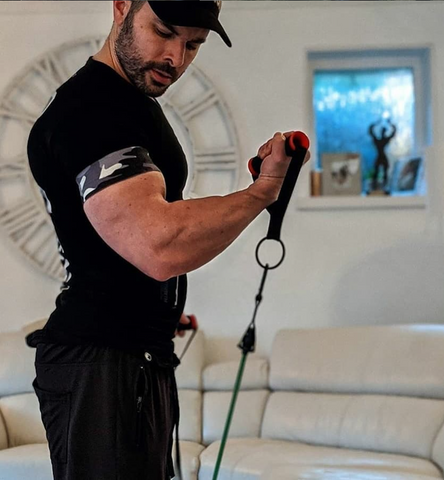
Gunsmith’s Complete Guide to Blood Flow Restriction Training
What is Blood Flow Restriction Training?
Sometimes referred to as Occlusion Training, and how it can give you some of the craziest pumps you’ve ever experienced. We’ll also be discussing the best practices for using BFRT bands, as well as which exercises and muscle groups respond well to BFRT. So grab a bottle of your favourite pre-workout drink, pull up a chair and let the learning begin.
While still slightly controversial, BFRT has seen an explosion in popularity in recent years. In many gyms, it’s become common place to see someone using BFRT bands almost daily, and we have no doubt that they will only become more popular in the near future.
Now before you decide to steal a couple of your dad’s neckties and wrap them around your legs during your squat routine, let’s go over some of the basics.
What are the Benefits?
Blood Flow Restriction Training, while incredibly simplistic, is very effective in promoting muscle growth and hypertrophy. At first glance, it may seem counter-intuitive: why would I want to restrict blood flow during my workout? Wouldn’t that actually be harmful to my muscles? While this seems like a common sense position, it’s the opposite of the truth.
Blood Flow Restriction Training, or BFRT, is a relatively novel training method when it comes to bodybuilding, weight lifting and power lifting. BFRT involves wrapping knee wraps, pressure cuffs, or specifically designed blood flow restriction bands around the upper portion of a limb. When done properly, the wrap will allow blood to flow into the limb, but restrict the flow coming out.
This type of restriction gives a massive pump to the muscle, which helps promote growth. BFRT has seen a boom in popularity in recent years, and for a good reason: it works.

Where and How Tight Should I Wrap my BFR Bands?
When using BFR bands, you want to wrap them at the top part of the chosen limb. If you’re exercising your arms, then you want the strap above your bicep. If you’re working legs, try getting the wrap as high up your leg as you can without pinching anything or restricting mobility.
As for the tightness, you want to make them tight enough that they restrict the veins but not the arteries. Arteries are what brings blood into the muscles, and veins allow the blood to flow out. By restricting the flow of the arteries, we are encouraging a ‘pooling’ effect of blood in our chosen muscle group.
This distinction is important to understand, because if you wrap your BFR straps too tight, you’ll restrict not only the veins but the arteries as well. This will actually PREVENT blood from coming into your muscles, which can actually hinder your muscle growth.
A lot of this is going to come down to personal experience and trial and error. Most people agree that a tightness level of 6 or 7 is the sweet spot when it comes to blocking veins but allowing blood to flow through the arteries.
Start slow and conservative with your BFR bands, and find how tight works best for you. You’ll know you’re at the right level of tightness when you can still lift easily, but are getting a more intense pump. Remember, it’s OK to be a little too ‘loose’ when you’re first starting out.

How Heavy/How Many Reps Should I Lift?
One of the greatest advantages of Blood Flow Restriction Training is its ability to use low intensity exercise to greatly increase muscle size. Ideally, you should be using BFR bands while lifting 40-50% of your 1 rep max.
This means you’ll be lifting for more reps, which promote hypertrophy and muscle pump. Try to aim for 15-30 repetitions. Keep in mind that it’s usually not necessary to workout to failure while using BFR wraps. It’s also been shown that rest times of around 30 seconds between sets is optimal for swelling and lactic acid accumulation, which promotes growth.
Which Exercises are Best for BFR Training?
As you may have already determined, BFR training can only be done on the arms and legs. At Gunsmith Fitness, we’ve determined that the best exercises to use with BFR for the legs is anything that works the entire leg: squats, lunges or farmer’s walk. This is because these exercises work every muscle in the leg, which draws much more blood in, increasing the beneficial effects of BFR training.
For arms, experiment with anything that you can do for high reps. Try supersetting your biceps with your triceps, or use drop sets to increase the volume of your routine.

What Type of Bands Should I Use?
The best type of BFR or Occlusion device on the market is still the original: the KAATSU Cycle product. This is a product developed in Japan, which uses a small air pump and monitoring station, along with specialized pneumatic elastic bands, to maintain a constant level of tightness around the chosen limb. That KAATSU unit also allows for cycling of pressure, which will allow the blood flow to return to normal along specific intervals.
While the KAATSU device allows for the greatest amount of control and customization, it comes at a steep price: the complete kit costs upwards of $1,000 US. For most of us, that’s way too much to spend on a piece of gym gear.
Luckily for you, dear reader, the geniuses at Gunsmith’s secret lab have adapted the most necessary features of the KAATSU device, namely the ability for customization, into a band that is much more affordable. Our bands are 2 inches (5cm) wide and made of premium elastic, so they allow for flexibility and won’t fray at the ends. Check out the different colors of our Blood Flow Restriction Training Bands here.

Conclusion
While it’s still a relatively new technique, Blood Flow Restriction Training has shown promise in increasing the size and strength of certain muscle groups. After you pick up some bands for yourself, experiment with the tightness (6-7 out of 10) and weight/reps to find out what your body responds to. Remember, it’s better to err on the side of too loose when first starting off with BFR Training, and as you become more familiar with the practice, you can tighten the bands up. Try using workouts that you know give you a good pump, and don't be afraid of throwing in some drop sets or supersets.





